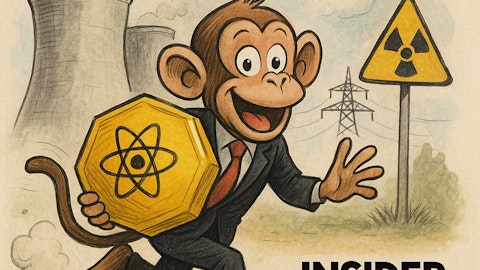“Is there a possibility of a proliferation problem in AI? Absolutely,” said Google’s former CEO Eric Schmidt. Speaking during a fireside chat at the Sifted Summit, a CNBC report reveals that Schmidt said the risks of AI proliferation “absolutely” exists and that people can learn to do a lot of bad things with it.
“There’s evidence that you can take models, closed or open, and you can hack them to remove their guardrails. So in the course of their training, they learn a lot of things. A bad example would be they learn how to kill someone.” Schmidt said.
“All of the major companies make it impossible for those models to answer that question. Good decision. Everyone does this. They do it well, and they do it for the right reasons. There’s evidence that they can be reverse-engineered, and there are many other examples of that nature.”
According to Schmidt, there isn’t a decent “non-proliferation regime” to restrain the dangers of AI yet.
For this article, we selected AI stocks by going through news articles, stock analysis, and press releases. These stocks are also popular among hedge funds. The hedge fund data is as of Q2 2025.
Why are we interested in the stocks that hedge funds pile into? The reason is simple: our research has shown that we can outperform the market by imitating the top stock picks of the best hedge funds. Our quarterly newsletter’s strategy selects 14 small-cap and large-cap stocks every quarter and has returned 427.7% since May 2014, beating its benchmark by 264 percentage points (see more details here).

10. Penguin Solutions, Inc. (NASDAQ:PENG)
Number of Hedge Fund Holders: 25
Penguin Solutions, Inc. (NASDAQ:PENG) is one of the 10 Trending AI Stocks on Wall Street. On October 8, Citizens reiterated its Market Outperform rating on the stock with a $26.00 price target. The rating affirmation follows the company’s fiscal fourth-quarter and full-year 2025 results.
The company reported revenue of $337.9 million for the fourth quarter, slightly below the consensus estimate of $342.5 million. In particular, its Integrated Memory segment demonstrated strong performance, generating revenue of $138.3 million.
This revenue represents an increase of 44% year-over-year, outperforming consensus expectations of $124.1 million which had estimated 29% growth.
The company’s non-GAAP earnings per share were $0.43, exceeding the consensus estimate of $0.38. This is despite the slight revenue miss in the quarter.
Penguin Solutions, Inc. (NASDAQ:PENG) is a leading AI and HPC computing company engaged in the design and development of enterprise solutions worldwide.
9. CoreWeave, Inc. (NASDAQ:CRWV)
Number of Hedge Fund Holders: 29
CoreWeave, Inc. (NASDAQ:CRWV) is one of the 10 Trending AI Stocks on Wall Street. On October 8, Evercore ISI analyst Amit Daryanani reiterated an Outperform rating on the stock with a $175.00 price target.
The firm is bullish on the stock, calling its profitability model strong based on its durable contracts, Nvidia’s backing, and long-term GPU demand.
“We think it is worth revisiting the topic of unit economics for CRWV, especially given investor concerns surrounding profitability/business model following yesterday’s Information article discussing the (low) profitability of ORCL’s GPU cloud business. Despite the capex intensity/debt financing required to deploy GPU clouds, we view CRWV’s model as durable, risk-managed, and profitable at scale even when taking high levels of depreciation expenses into account. Key considerations: 1) Multi-year Take-or-Pay/Noncancelable Contracts: CRWV sees an average 4-year duration for customer contracts (have been trending more toward 5 or more for more recent deals). 2) Built-to-Suit, Not On Spec: CRWV’s capacity is built not on spec and only developed once customer contracts are signed; the company typically receives prepayments equating to ~15–25% of TCV to fund initial capex requirements (GPUs, DC capacity). 98% of revenue is from reserved capacity. 3) NVDA MSA Provides Margin of Safety: In the event that CRWV does have unutilized capacity, NVDA is obligated to purchase the residual unsold capacity through April 2032. 4) Potential for Useful Lives > 6 Years: Management has pointed to several anecdotes/proof points that provide them with confidence they can continue to monetize GPUs well past their useful lives (Volta GPUs still in use, multi-year Hopper contracts continue to be signed, customers comfortable with signing 5–6 year Grace Blackwell contracts). Our analysis of a hypothetical ~$3.2B TCV 4-year GB200 contract resulting in ~$1B of capex, suggests that once deployed, CRWV should be able to return 40–50% incremental EBIT margins (potential for upside in EBIT margins beyond year-6 once hardware is fully depreciated) and ~70% incremental EBITDA margin. With the differences between incremental margins in our analysis and CRWV’s current mid-teens margin profile is more attributed to accelerated investments to support growth, revenue timing, and lower scale (currently). Net/net: We continue to hold a positive view on CRWV fundamentals. Maintain OP/$175 Target.”
CoreWeave, Inc. (NASDAQ:CRWV) is a cloud platform provider that provides equipment for AI and other computing purposes.





